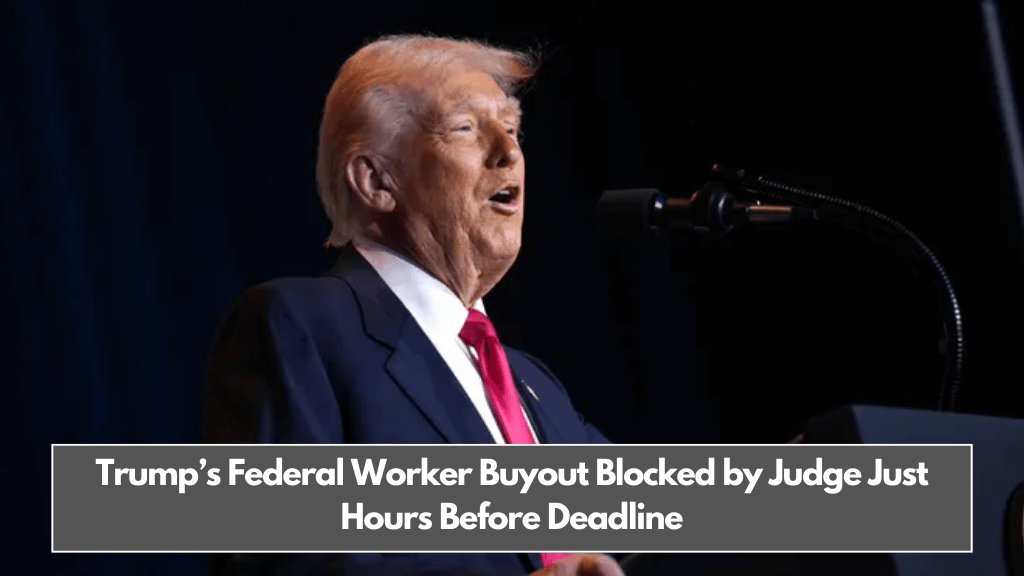A federal judge temporarily halted the Trump administration’s controversial plan requiring more than 2 million federal employees to decide by February 6 whether to accept a buyout offer or remain in their positions. The decision gives labor unions time to challenge the legality of the administration’s proposed workforce reductions.
What Led to the Temporary Restraining Order?
U.S. District Judge George O’Toole issued a temporary restraining order on Thursday and scheduled a hearing for Monday. The order came after unions representing federal workers filed legal challenges, arguing that the buyout violated established federal labor laws and procedures.
The administration had argued against the delay, claiming it would cause disruption, uncertainty, and hinder efforts to streamline the federal workforce. Despite the objections, the judge granted the temporary pause, offering unions a chance to present their case.
The Administration’s “Once-in-a-Lifetime” Buyout Offer
Under the plan, federal employees who agreed to resign by February 6 would receive eight months of pay and benefits through September 2025. However, labor unions and critics quickly raised concerns, pointing out that key details were missing from the offer.
Workers considering the buyout were not provided clarity on:
- Whether they could take private sector jobs while still receiving government benefits
- How pensions, health insurance, and retirement benefits would be affected
- Whether they could be required to perform any government work during the buyout period
Adding to the uncertainty, Congress has only approved funding for federal agencies through March 14, making it unclear how the administration would fulfill its promise of continued pay and benefits.
Union Leaders and Worker Concerns
Everett Kelley, president of the American Federation of Government Employees, vowed to fight for workers’ rights, calling the offer an “unprecedented” move by the administration.
Union leaders argue that the offer was rushed and did not follow proper federal procedures for downsizing the workforce. Workers were given little more than a week to make life-changing decisions about their careers without sufficient information or assurances.
Some employees expressed fear and uncertainty, worried that staying in their jobs could result in being forced into harsher working conditions, while accepting the buyout could leave them vulnerable if funding or benefits fall through.
Critics: A Push to Drive Out Federal Workers
Critics accuse the Trump administration of creating a work environment designed to drive out federal employees. The administration has implemented several measures, including:
- Mandatory Return to In-Person Work: Employees who choose to stay must report to the office full-time.
- New Performance Standards: Workers face stricter evaluations and requirements to be “reliable, loyal, and trustworthy.”
- Widespread Downsizing: Most federal agencies, except the Defense Department, are expected to undergo significant staff reductions.
The administration has made clear that employees who do not accept the buyout risk furloughs or layoffs. Many believe that the goal is to replace long-serving civil servants, some of whom are perceived as being resistant to the administration’s policies, with loyal appointees.
Current Buyout Acceptance Numbers
As of Thursday morning, approximately 40,000 federal workers, or about 2% of the federal workforce, had accepted the buyout offer. This falls short of the administration’s goal of 5% to 10%, which they hoped would help significantly reduce the size of the government.
White House press secretary Karoline Leavitt described the buyout as a “very generous, once-in-a-lifetime offer” and welcomed the extension granted by the judge, saying it would allow more employees to consider taking the deal.
What Happens Next?
The legal battle over the buyout will continue during Monday’s court hearing, where unions will present their case against the administration’s plan. If the court rules in favor of the unions, the administration may be forced to alter or abandon the buyout offer.
Meanwhile, uncertainty remains for federal employees as they weigh the risks of staying in their current roles or accepting the buyout.
The temporary pause offers a glimmer of hope for federal workers and labor unions seeking more clarity and protection. However, the broader battle over the future of the federal workforce—and the Trump administration’s push to reshape it—remains far from over.
The outcome of the legal challenges could have long-term implications for the rights of public employees and the structure of the federal government.
